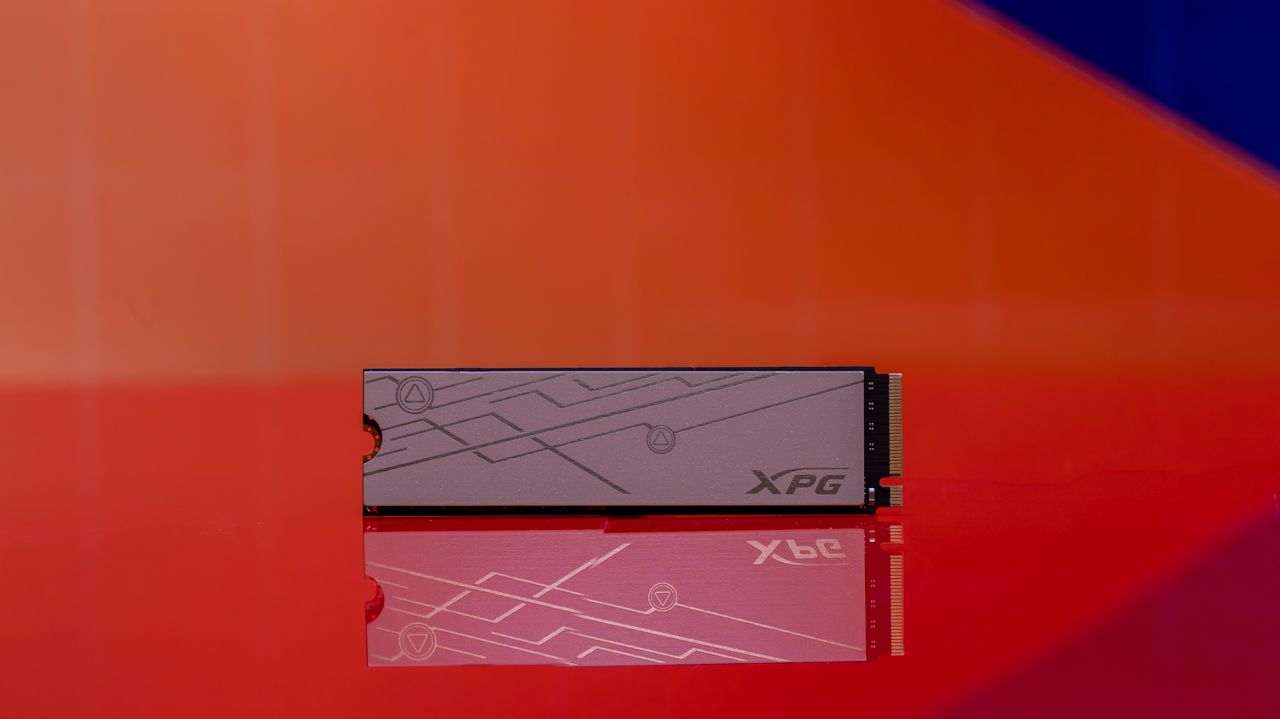
Design: Heat Spreader Included
The Mars 980 Blade is a four-lane solid-state drive that operates using the NVMe 2.0 protocol over a PCIe 5.0 bus. This internal SSD comes in the standard M.2 Type-2280 "gumstick" format. The two-sided drive features chips on both sides, utilizing Micron's B58R 232-layer 3D TLC NAND flash and a Silicon Motion SM2508 controller, which is designed for high performance and energy efficiency.
The SM2508 is a relatively new controller, also found in the Crucial T710 and Lexar NM1090 Pro. Unlike some DRAM-less SSDs, the SM2508 has its own cache of dynamic random access memory (DRAM), providing an advantage in certain performance scenarios. The Mars 980 Blade includes a thin aluminum heat spreader that can be attached to the side with the exposed chips (the controller and NAND flash). This compact design allows the SSD to easily fit into the secondary M.2 slot of a Sony PlayStation 5. However, it's important to note that the PS5 supports only PCIe 4.0, so when used in this manner, the Blade will operate at PCIe 4.0 speeds, peaking at around 5,000MBps.
The Mars 980 Blade is available in capacities of 1TB, 2TB, and 4TB. Based on list prices, these options offer competitive pricing for a PCIe 5.0 SSD. The actual street price is typically lower than the listed price. In terms of durability, measured by the total terabytes written (TBW), the Blade outperforms several other models, including the Corsair MP700 Pro, ADATA Legend 970, and Gigabyte Aorus 10000 Gen 5. It also surpasses the Crucial T700, T705, and T710 in durability ratings. The Seagate FireCuda 540 remains the top performer in this category.
ADATA offers a five-year warranty for the Mars 980 Blade, or until the rated TBW is reached, whichever comes first. For data security, the Blade supports the Pyrite specification for drive access control but does not encrypt the data itself. Users can manage their drives using the ADATA SSD Toolbox, a free utility suite that includes tools for health monitoring, diagnostics, optimization, benchmarking, and backups.
Compatibility: Your Bus Fare May Be Hefty
PCIe 5.0 SSDs, including the Mars 980 Blade, promise significant speed improvements over PCIe 4.0 drives. However, to take full advantage of these speeds, you need hardware that supports the PCIe 5.0 standard. Most recent desktops and a few laptops may have this capability, but it's often necessary to build a custom PC or upgrade an existing system to achieve compatibility. On desktops, you'll need an Intel 12th Gen or later Core CPU with a motherboard based on a late-model Intel chipset that supports PCIe 5.0, or an AMD Ryzen 7000 or 9000 processor with an AM5 motherboard built around a late-model chipset that supports PCIe 5.0.
It’s important to note that even if your motherboard has a compatible chipset, it doesn’t guarantee that it includes a PCIe 5.0-capable M.2 slot. This feature is determined by the motherboard manufacturer, so it's crucial to check the specifications and documentation of your system or motherboard before purchasing a PCIe 5.0 SSD.
Speed Testing: PCMark 10 Performance Needs More Pep
In testing the Mars 980 Blade, we used a dedicated testbed PC designed for benchmarking PCIe 5.0 M.2 SSDs. This setup included an ASRock X670E Taichi motherboard with an AMD X670 chipset, 32GB of DDR5 memory, one PCIe 5.0 x4 M.2 slot, and three PCIe 4.0 slots. The system was powered by an AMD Ryzen 9 7900 CPU, paired with a GeForce RTX 2070 Super graphics card and a Thermaltake Toughpower GF1 Snow 750-watt power supply. The boot drive was an ADATA Legend 850 PCIe 4.0 SSD.
We tested the Blade using Crystal DiskMark 6.0, UL's PCMark 10 Storage, and UL's 3DMark Storage Benchmark. The results showed that the Blade exceeded its sequential read and write speed ratings, placing it among elite Gen 5 performers. It also delivered strong random 4K read and write results, ranking third in 4K read speed and second in 4K write speed.
In the PCMark 10 Overall Storage test, the Blade scored near the bottom of the Gen 5 group, just above the Crucial P510 and Addlink G55H, both of which are DRAM-less SSDs. The Blade's individual trace-based tests showed middling results, with the slowest performance in the Photoshop launching test and the second-slowest in the Windows boot test.
In the 3DMark Storage Benchmark, the Blade scored second-lowest among the comparison group, ahead only of the Lexar NM1090 Pro. Overall, the Mars 980 Blade performs best for straight-line file transfers, archiving, and accessing data. Its performance generally places it near the bottom of the Gen 5 pack, closer to DRAM-less SSDs like the Lexar NM1090. It often lags behind the top PCIe 4.0 SSDs, such as the Crucial T500 and WD Black SN850X.
0 comments:
Ikutan Komentar